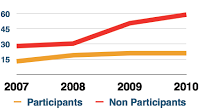
Chicago is America’s windy city. And nowhere was this more obvious than at RSNA’s 97th Scientific Assembly and Annual Meeting. Lakeshore Drive was even shut down because of the high winds and Lake Michigan surges.

Chicago is America’s windy city. And nowhere was this more obvious than at RSNA’s 97th Scientific Assembly and Annual Meeting. Lakeshore Drive was even shut down because of the high winds and Lake Michigan surges.
Less literal but equally real, within the walls of McCormick Place another strong wind was blowing: that of technology in transition. Over 50,000 attendees welcomed trends and terms such as cloud, virtual and augmented reality. Technology and imaging vendors weren’t just leading edge; you could say they were even getting a bit sci-fi. Four trends stuck out.
1. Radiologists Blown Away by Meaningful Use
A bit disenfranchised in Phase One, seasoned radiologists were eager to learn more looked more during several standing-room-only sessions about Meaningful Use. Wide-eyed and weary, radiologists were left trying to figure out how they’ll be involved and what new data points they need for MU reporting.
All that interest points to yet another development in the coming months, as there’s a lot of money to be had for radiologists as part of the ARRA stimulus package and meaningful use. I’m sure that in the coming year, they’ll be trying to figure out how to comply…and get the dough.
2. Cloudy With a Chance of PACS
Cloud-enabling PACS was a hot topic in vendor booths and among attendees. With PACS vendors claiming to have their own cloud-based solutions, the move to virtual software as a service and remote hosting appears to be “when”, not “if”. Information gathering and questions about cloud computing were very common. Specific questions included:
– What is the cloud?
– What’s the difference between cloud, remote hosting, software as a service, and virtualization?
– How does my PACS cloud option for image storage differ from a true, cloud-based vendor neutral archive (VNA)?
– How many technology layers are there; and what vendors are involved?
Just like us IT geeks, radiologists of all ages and stages were tethered to their iPads and iPhones at RSNA. Radiologists expect the same ease of access with medical images as they get with family photos on their smart phones; and they want vendors to deliver a similar experience, while ensuring compliance and containing costs.
3. Collaboration and Image Exchange
Highly competitive and prone to seclusion within their own silos of care, it was obvious by roaming each of the three massive exhibit halls that times are changing for these professionals. Image sharing, collaboration and exchange were themes of the day. Younger radiologists understand these needs by the nature of the environments and devices with which they interact daily, while older radiologists see the need for it but seem to be struggling to adopt change.
It’s no secret that the Tsunami of Data is fast approaching, and with it, a new set of challenges revolving around the effective and efficient management of imaging storage. Freedom of choice, increased flexibility and cost efficiency provide the impetus behind image sharing, with Universal viewers and VNAs acting as some of the key delivery mechanisms.
This model is making single-vendor approaches to medical imaging obsolete: gone may be the days when one large vendor such as GE or Siemens provides all the imaging technology for an entire organization. This is especially true as hospitals acquire imaging centers or merge to create ACOs.
Vendor agnostic environments and the ability to use and view images regardless of where they were created or stored will be the norm going forward. Expect to see more developments at future RSNAs.
4. A Tornado of Medical Advances
Maybe it was the augmented reality 3D tool. Or perhaps it was instant collaboration via multi-touch devices. Either way, the technology presented at RSNA is fast approaching science fiction – and beyond.
Some attendees to a keynote session had the chance to see (and touch) a replica of the presenter’s brain, created with a 3D printer. There was even a scientific study demonstrating the use of CT Scanning technology in the reconstruction of a 1704 Stradivari violin. It’s clear that these new technologies provide unique avenues to creatively merge art and science, but more importantly, they translate into real advancements in diagnostic capabilities, positively impacting patient outcome.
Today’s imaging solutions read the brain waves of ADHD kids and identify differences in neurological processing. They give radiologists and interventionists full patient access without putting patients into tight-spaces or claustrophobic tunnels. Even premature infants have their own imaging incubators. Scientists are also developing new algorithms that generate mathematical models of the brain, enabling more accurate diagnosis based on thickness levels that could be associated with Alzheimer’s disease. And these are just a few examples.
Laser-guided, virtual, holographic and 3-D, the imaging technology at this year’s RSNA eliminates compromise. Yes you can have both….impeccable image quality and complete mobility.
Overall, RSNA is an experience every healthcare IT professional should enjoy. The confluence of technology and medical advances show no sign of the economic slow-down or healthcare reform concerns. As one radiologist roaming the aisles excitedly stated….”I love this place, there are just so many toys”!
I certainly look forward to RSNA 2012, and all the new developments in these areas.
This guest post was provided by Mariano Maluf, Chief Technology Officer of GNAX:
Follow Mariano on Twitter at https://twitter.com/#!/mjmaluf







